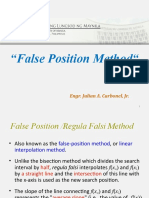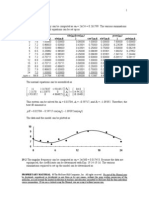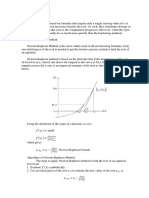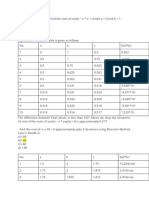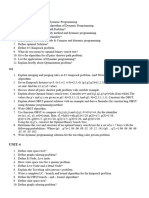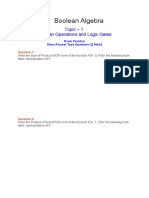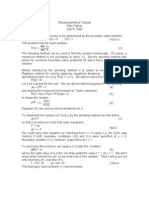Numerical Solution of Non-Linear Equations (Root Finding Method)
Uploaded by
beena saleemNumerical Solution of Non-Linear Equations (Root Finding Method)
Uploaded by
beena saleemNumerical solution of non-linear equations Bisection method Instructor: Miss Urooj
Numerical solution of non- linear equations
(Root finding method)
1. Open Methods
Newton’s Rapson Method
Secant Method
2. Closed Methods (Bracketing Methods)
Bisection Method
False Position Method
Errors
1. True Errors
Percentage Relative Error
𝑡𝑟𝑢𝑒 𝑣𝑎𝑙𝑢𝑒−𝐴𝑝𝑝𝑟 𝑉𝑎𝑙𝑢𝑒
𝜀𝑡 = | |*100
𝑇𝑟𝑢𝑒 𝑣𝑎𝑙𝑢𝑒
Absolute Error |𝑡𝑟𝑢𝑒 𝑣𝑎𝑙𝑢𝑒 − 𝑎𝑝𝑝𝑟𝑜𝑥𝑖𝑚𝑎𝑡𝑒 𝑣𝑎𝑙𝑢𝑒|
2. Estimated Error
𝑥3𝑛𝑒𝑤 −𝑥3𝑜𝑙𝑑
Percentage Relative Error 𝜀𝑎 = | |*100
𝑥3𝑛𝑒𝑤
Absolute Error |𝑥𝑛𝑒𝑤
3 − 𝑥𝑜𝑙𝑑
3 |
Closed Method
Bisection Method
Formula 𝑥1 + 𝑥2
𝑥3 =
2
If 𝑓(𝑥1) ∗ 𝑓(𝑥3 ) < 0 set 𝑥2 = 𝑥3
𝑓 (𝑥1 ) ∗ 𝑓 (𝑥3 ) > 0 set 𝑥1 = 𝑥3
Numerical solution of non-linear equations Bisection method Instructor: Miss Urooj
Question: Determine the real root of 𝑓 (𝑥 ) = −0.5𝑥 2 + 2.5𝑥 + 4.5
(a). Using the three iterations of bisection method to determine the highest root.
Employ the initial guesses of 𝑥𝑙 = 5, and 𝑥𝑢 = 10. Compute the estimated error
and true error after each iteration.
(b). Using the quadratic formula.
Solution:
(b). Apply quadratic formula.
Roots are 6.4051, -1.4051
(a). Bisection method
𝑥1 = 5 , 𝑓 (𝑥1 = 5) = 4.5
𝑥2 = 10, 𝑓(𝑥2 ) = −20.5
𝑥3 𝜀𝑡
Iterations 𝑥1 𝑥2 f(𝑥3 ) f(𝑥1 )f(𝑥3 ) 𝜀𝑎
6.4051 − 7.5
-21.9375<0 | | ∗ 100
0 5 10 7.5 -4.875 _ 6.4051
𝑥2 = 𝑥3
=17.0937%
4.5*0.593 = 6.25 − 7.5 6.4051 − 6.25
| | ∗ 100 | | ∗ 100
1 5 7.5 6.25 0.5937 2.6718>0 6.25 6.4051
𝑥1 = 𝑥3 =20% = 2.42189%
0.5937*- 6.875 − 6.25 6.4051 − 6.875
| | ∗ 100 | | ∗ 100
2 6.25 7.5 6.875 -1.9453 1.9453 6.875 6.4051
-1.1550<0 =9.091% =7.3359%
Ans. The real root of given equation is 6.875
Numerical solution of non-linear equations Bisection method Instructor: Miss Urooj
Question: Determine a real root of 𝑓(𝑥 ) = 5𝑥 3 − 5𝑥 2 + 6𝑥 − 2
Using bisection method to locate the root. Employ the initial guesses of 𝑥𝑙 = 0,
and 𝑥𝑢 = 1 and iteration until the estimated error 𝜀𝑎 fall below the level of 10%.
Solution:
𝒙𝟏 +𝒙𝟐
𝑥1 = 0 , 𝑓 (𝑥1 = 0) = -2 𝒙𝟑 =
2
𝑥2 = 1, 𝑓 (𝑥2 ) = 4
𝜺𝒂
Iterations 𝒙𝟏 𝒙𝟐 𝒙𝟑 f(𝒙𝟑 ) f(𝒙𝟏 )f(𝒙𝟑 ) 𝑥3𝑛𝑒𝑤 −𝑥3𝑜𝑙𝑑
𝜀𝑎 = | |*100
𝑥3𝑛𝑒𝑤
-0.75<0
0 0 1 0.5 --
𝒙𝟐 = 𝒙𝟑
1.46876>0
1 0 0.5 0.25 100%
𝒙𝟏 = 𝒙𝟑
0.13913>0
2 0.25 0.5 0.375 33.3%
𝒙𝟏 = 𝒙𝟑
-0.01642<0
3 0.375 0.5 0.4375 14.285%
𝒙𝟐 = 𝒙𝟑
0.00994>0
4 0.375 0.4375 0.40625 7.692%
𝒙𝟏 = 𝒙𝟑
The real root of given equation is 0.40625, with 7.692% error.
Numerical solution of non-linear equations Bisection method Instructor: Miss Urooj
Question: Determine a real root of 𝑓(𝑥 ) = 𝑥 3 − cos(𝑥) − 1
Use bisection method to locate a real root of function, and iteration until the
estimated error 𝜀𝑎 fall below the level of 10%.
Solution: (convert the mode of calculator in radians)
Let 𝑥1 = 0 𝑎𝑛𝑑 𝑥2 = 2
𝒙𝟏 +𝒙𝟐
At, 𝑥1 = 0 , 𝑓 (𝑥1 ) = −2 𝒙𝟑 =
2
And at, 𝑥2 = 2, 𝑓(𝑥2 ) = 7.41615
𝜺𝒂
Iterations 𝒙𝟏 𝒙𝟐 𝒙𝟑 f(𝒙𝟑 ) f(𝒙𝟏 )f(𝒙𝟑 ) 𝑥3𝑛𝑒𝑤 −𝑥3𝑜𝑙𝑑
𝜀𝑎 = | 𝑥3𝑛𝑒𝑤
|*100
1.080604 >0
0 0 2 1 -0.540302 --
𝒙𝟏 = 𝒙𝟑
-1.244998<0
1 1 2 1.5 2.304263 33.33%
𝒙𝟐 = 𝒙𝟑
-0.344606<0
2 1 1.5 1.25 0.637803 20%
𝒙𝟐 = 𝒙𝟑
0.0039701>0
3 1 1.25 1.125 -0.007348 11.11%
𝒙𝟏 = 𝒙𝟑
-0.002209<0
4 1.125 1.25 1.1875 0.300581 5.263%
𝒙𝟐 = 𝒙𝟑
The real root of given equation is 1.1875, with 5.263% error.
You might also like
- Numerical Methods For Engineers Solution Manual 7th: Click Here Read/Download0% (2)Numerical Methods For Engineers Solution Manual 7th: Click Here Read/Download2 pages
- Numerical Method For Engineers-Chapter 7No ratings yetNumerical Method For Engineers-Chapter 722 pages
- "False Position Method": Engr. Julian A. Carbonel, JR0% (1)"False Position Method": Engr. Julian A. Carbonel, JR12 pages
- Chapter # 2 Solution of Algebraic and Transcendental Equations100% (2)Chapter # 2 Solution of Algebraic and Transcendental Equations31 pages
- Lab 01 Bisection Regula-Falsi and Newton-RaphsonNo ratings yetLab 01 Bisection Regula-Falsi and Newton-Raphson12 pages
- Newton's Divided Difference Interpolation FormulaNo ratings yetNewton's Divided Difference Interpolation Formula31 pages
- C03.01 MEC500RK Roots of Equation - Bracketing MethodNo ratings yetC03.01 MEC500RK Roots of Equation - Bracketing Method28 pages
- Ch5 Bracketing Methods Compatibility ModeNo ratings yetCh5 Bracketing Methods Compatibility Mode33 pages
- Numerical Methods For Engineers (6 Edition)67% (3)Numerical Methods For Engineers (6 Edition)14 pages
- Module 1 - Introduction To Numerical Methods PDFNo ratings yetModule 1 - Introduction To Numerical Methods PDF20 pages
- Simple Fixed Point Iteration Method PDFNo ratings yetSimple Fixed Point Iteration Method PDF11 pages
- Roots: EEE 305 Lecture 3: Bracketing Methods For Finding RootsNo ratings yetRoots: EEE 305 Lecture 3: Bracketing Methods For Finding Roots7 pages
- SMA 3261 - Lecture 6 - Numerical Integration100% (1)SMA 3261 - Lecture 6 - Numerical Integration14 pages
- Chapter 5: Roots of Equations - Bracketing Methods: Lesson PlanNo ratings yetChapter 5: Roots of Equations - Bracketing Methods: Lesson Plan21 pages
- Lab Experiment # 2: Root Finding Using Bisection & False Ppsition MethodsNo ratings yetLab Experiment # 2: Root Finding Using Bisection & False Ppsition Methods6 pages
- Solution Manual for Numerical Methods for Engineers, 8th Edition By Steven Chapra Raymond Canale - Download Now And Never Miss A Chapter100% (6)Solution Manual for Numerical Methods for Engineers, 8th Edition By Steven Chapra Raymond Canale - Download Now And Never Miss A Chapter47 pages
- Chapra Numerical Analysis 11th Chapter SolutionNo ratings yetChapra Numerical Analysis 11th Chapter Solution26 pages
- Numerical Method For Engineers-Chapter 19No ratings yetNumerical Method For Engineers-Chapter 1925 pages
- Bracketing Methods: Methods Because Two Initial Guesses For The Root Are Required. As The Name Implies, TheseNo ratings yetBracketing Methods: Methods Because Two Initial Guesses For The Root Are Required. As The Name Implies, These15 pages
- Open Methods (Newton-Raphson Secant Methods)100% (1)Open Methods (Newton-Raphson Secant Methods)4 pages
- Assignment of Bisection Method Solution: Computer Oriented Numerical Methods - 2620004No ratings yetAssignment of Bisection Method Solution: Computer Oriented Numerical Methods - 26200043 pages
- EL - 224 Microprocessor Based Systems: Experiment# 06No ratings yetEL - 224 Microprocessor Based Systems: Experiment# 066 pages
- EL - 224 Microprocessor Based Systems: Experiment# 04No ratings yetEL - 224 Microprocessor Based Systems: Experiment# 049 pages
- Solution of Linear Programing Problems Graphical MethodNo ratings yetSolution of Linear Programing Problems Graphical Method5 pages
- Optimisasi Fungsi Nonlinier Dua Variabel Bebas Dengan Satu Kendala Pertidaksamaan Menggunakan Syarat Kuhn-TuckerNo ratings yetOptimisasi Fungsi Nonlinier Dua Variabel Bebas Dengan Satu Kendala Pertidaksamaan Menggunakan Syarat Kuhn-Tucker6 pages
- Unit 6 Introduction To Sequential LogicNo ratings yetUnit 6 Introduction To Sequential Logic34 pages
- Scientific Computing - LESSON 13: Numerical Integration II 1No ratings yetScientific Computing - LESSON 13: Numerical Integration II 15 pages
- CENTRAL DIFFERENCE INTERPOLATION FORMULA Exercises With Solution100% (1)CENTRAL DIFFERENCE INTERPOLATION FORMULA Exercises With Solution3 pages
- ITPACK 2C: A FORTRAN Package For Solving Large Sparse Linear Systems by Adaptive Accelerated Iterative MethodsNo ratings yetITPACK 2C: A FORTRAN Package For Solving Large Sparse Linear Systems by Adaptive Accelerated Iterative Methods21 pages
- Example 2:: Find The Zeroes of The Quadratic Polynomial XNo ratings yetExample 2:: Find The Zeroes of The Quadratic Polynomial X8 pages
- Algebra Basic Concepts Formulas For SSC Railway Exams0% (1)Algebra Basic Concepts Formulas For SSC Railway Exams6 pages
- ! Diet Problem Given in The Note : Model TitleNo ratings yet! Diet Problem Given in The Note : Model Title2 pages
- Numerical Methods For Engineers Solution Manual 7th: Click Here Read/DownloadNumerical Methods For Engineers Solution Manual 7th: Click Here Read/Download
- "False Position Method": Engr. Julian A. Carbonel, JR"False Position Method": Engr. Julian A. Carbonel, JR
- Chapter # 2 Solution of Algebraic and Transcendental EquationsChapter # 2 Solution of Algebraic and Transcendental Equations
- C03.01 MEC500RK Roots of Equation - Bracketing MethodC03.01 MEC500RK Roots of Equation - Bracketing Method
- Roots: EEE 305 Lecture 3: Bracketing Methods For Finding RootsRoots: EEE 305 Lecture 3: Bracketing Methods For Finding Roots
- Chapter 5: Roots of Equations - Bracketing Methods: Lesson PlanChapter 5: Roots of Equations - Bracketing Methods: Lesson Plan
- Lab Experiment # 2: Root Finding Using Bisection & False Ppsition MethodsLab Experiment # 2: Root Finding Using Bisection & False Ppsition Methods
- Solution Manual for Numerical Methods for Engineers, 8th Edition By Steven Chapra Raymond Canale - Download Now And Never Miss A ChapterSolution Manual for Numerical Methods for Engineers, 8th Edition By Steven Chapra Raymond Canale - Download Now And Never Miss A Chapter
- Bracketing Methods: Methods Because Two Initial Guesses For The Root Are Required. As The Name Implies, TheseBracketing Methods: Methods Because Two Initial Guesses For The Root Are Required. As The Name Implies, These
- Assignment of Bisection Method Solution: Computer Oriented Numerical Methods - 2620004Assignment of Bisection Method Solution: Computer Oriented Numerical Methods - 2620004
- EL - 224 Microprocessor Based Systems: Experiment# 06EL - 224 Microprocessor Based Systems: Experiment# 06
- EL - 224 Microprocessor Based Systems: Experiment# 04EL - 224 Microprocessor Based Systems: Experiment# 04
- Solution of Linear Programing Problems Graphical MethodSolution of Linear Programing Problems Graphical Method
- Optimisasi Fungsi Nonlinier Dua Variabel Bebas Dengan Satu Kendala Pertidaksamaan Menggunakan Syarat Kuhn-TuckerOptimisasi Fungsi Nonlinier Dua Variabel Bebas Dengan Satu Kendala Pertidaksamaan Menggunakan Syarat Kuhn-Tucker
- Scientific Computing - LESSON 13: Numerical Integration II 1Scientific Computing - LESSON 13: Numerical Integration II 1
- CENTRAL DIFFERENCE INTERPOLATION FORMULA Exercises With SolutionCENTRAL DIFFERENCE INTERPOLATION FORMULA Exercises With Solution
- ITPACK 2C: A FORTRAN Package For Solving Large Sparse Linear Systems by Adaptive Accelerated Iterative MethodsITPACK 2C: A FORTRAN Package For Solving Large Sparse Linear Systems by Adaptive Accelerated Iterative Methods
- Example 2:: Find The Zeroes of The Quadratic Polynomial XExample 2:: Find The Zeroes of The Quadratic Polynomial X
- Algebra Basic Concepts Formulas For SSC Railway ExamsAlgebra Basic Concepts Formulas For SSC Railway Exams









